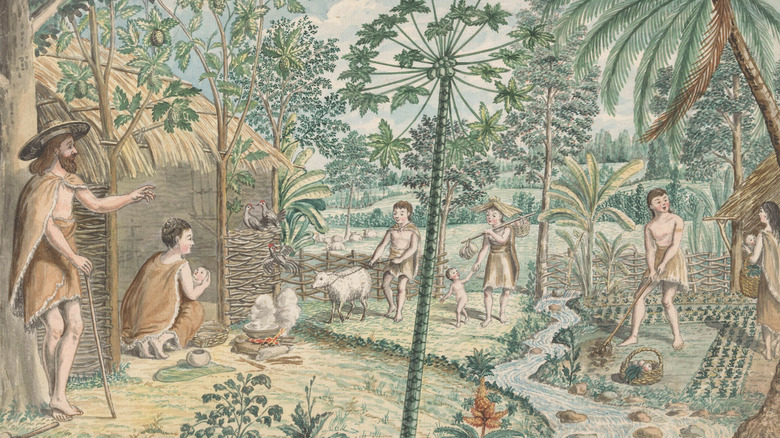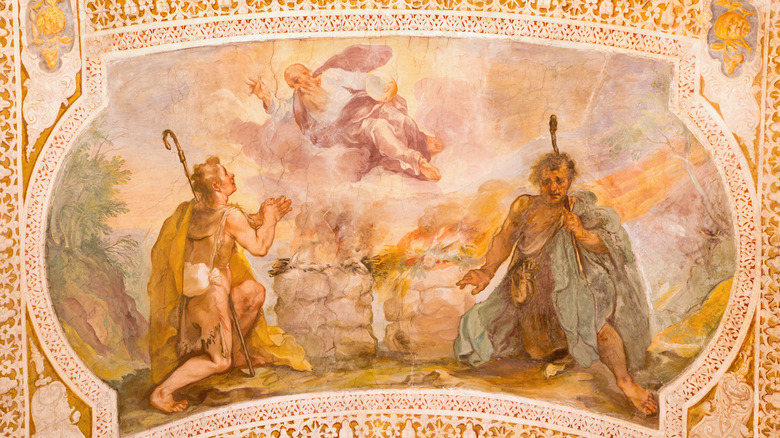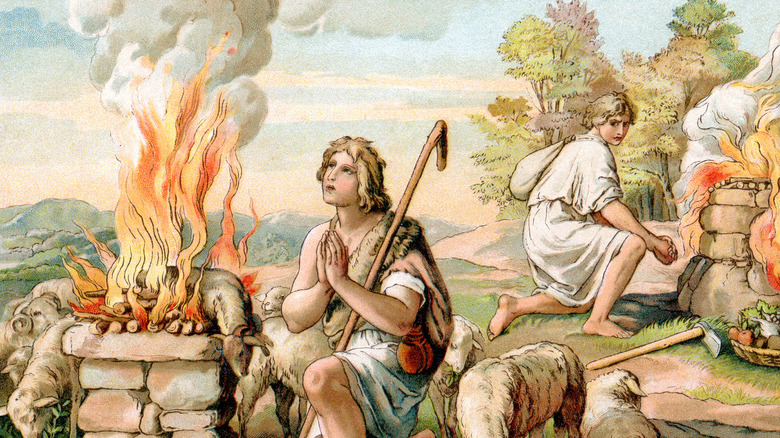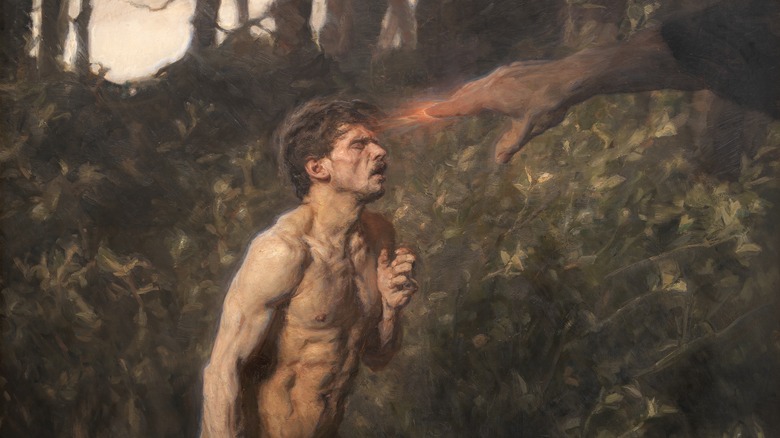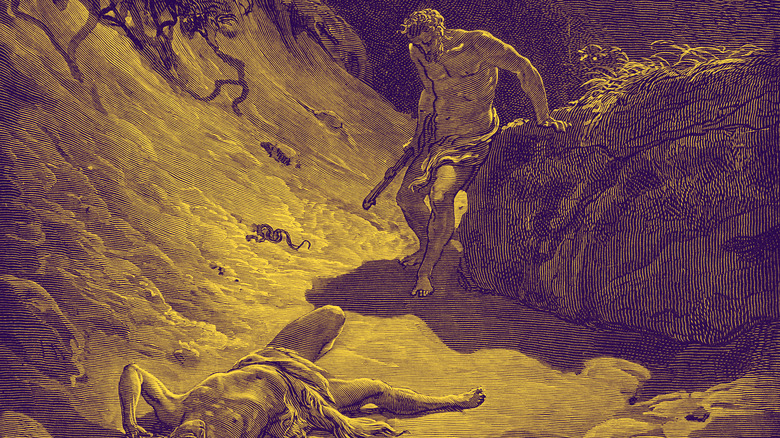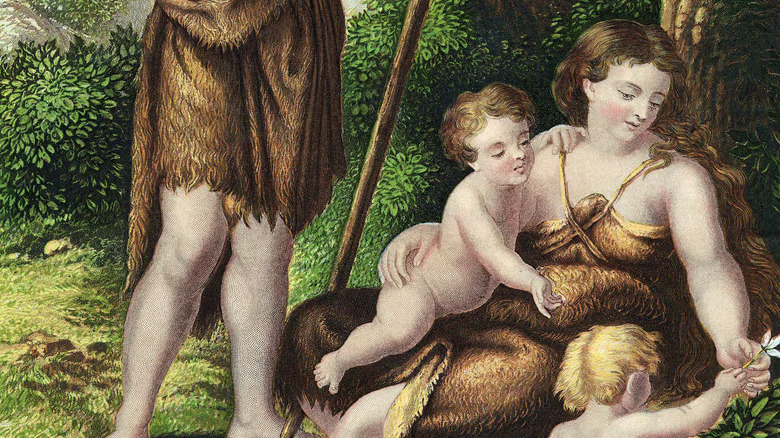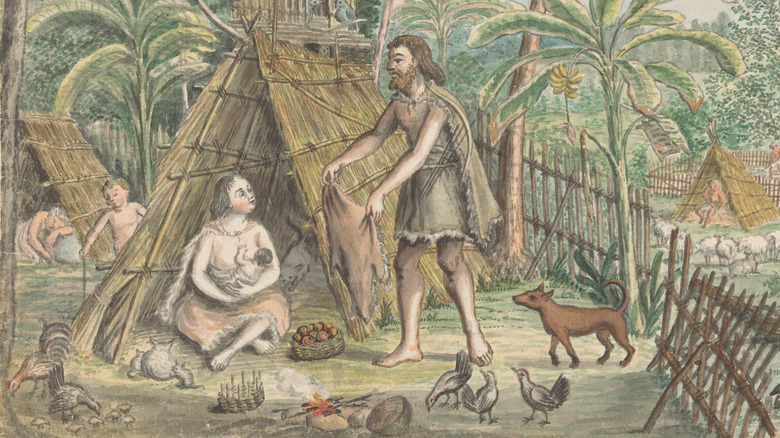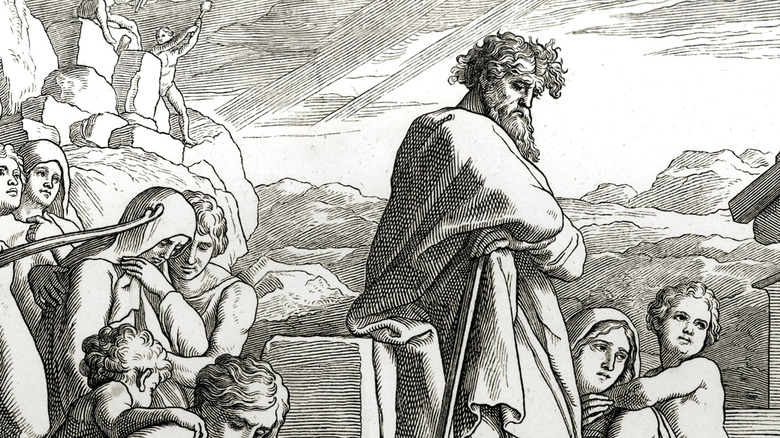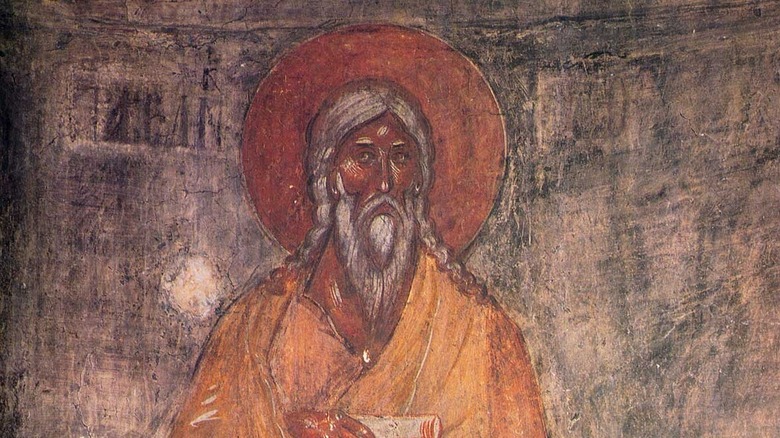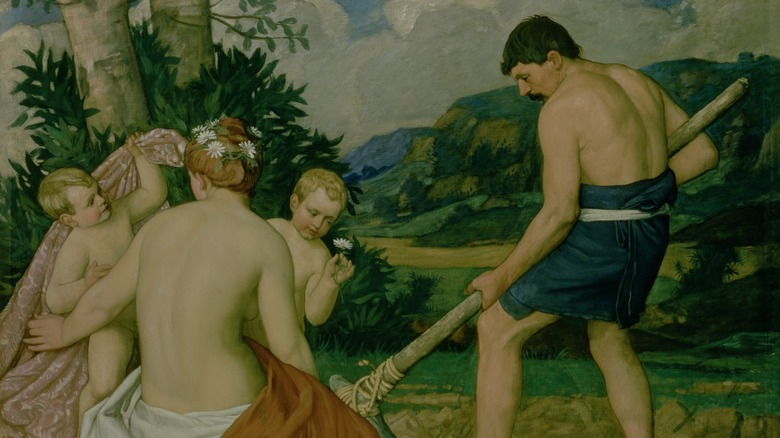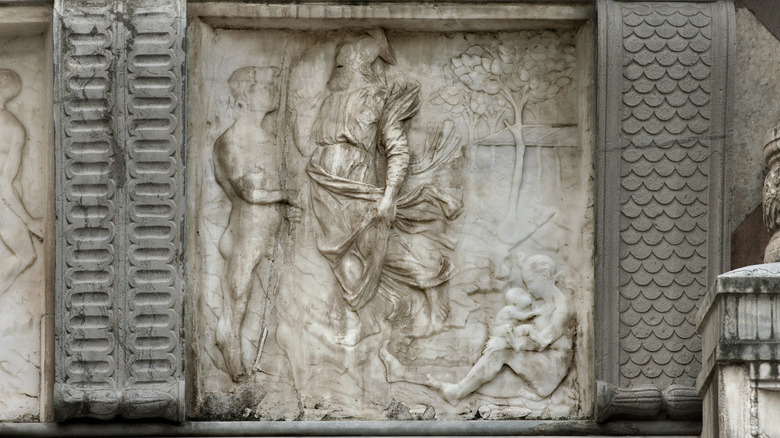The Hidden Truth About Adam And Eve's Children
Just about all of the information we have about the story of Adam and Eve, at least in an official sort of sense, comes from the Hebrew scriptures known as the Tanakh, which were later included in the Old Testament of the Christian Bible. In fact, the only mentions of the two come in the earliest verses of the book of Genesis (known as Bereshit in the Tanakh). Yet, for all its brevity, the story of Adam and Eve is a dramatic one. As the story goes, they were the first known humans to be created, but they upended it all after eating forbidden fruit and subsequently getting kicked out of the paradisiacal Garden of Eden. Things got even worse when they had children. One son, Cain, decided to murder his brother, Abel, for what seem to be petty reasons based on jealousy (though there are likely plenty of things that nobody told you about Cain and Abel that may complicate that notion).
But Eve and Adam did not stop there. Genesis directly mentions a third son, Seth, and rather vaguely throws off a line saying that Adam had yet more sons and daughters after Seth's birth. Beyond that, the text of Genesis is often frustratingly vague, leaving many people in the intervening centuries to come up with their own folklore and individual ideas about not just the named children of Adam and Eve but the unnamed ones, too.
Only three sons are named in the Bible
If you only refer to the Bible for information about Adam and Eve's children, you'll find few details. Genesis only bothers to mention three of those offspring, and they're all sons. The firstborn of this group, according to Genesis 4, is Cain, who is soon followed by his brother Abel. In the space of just a few lines, they grow up and take on jobs: shepherd for Abel and farmer for Cain. Both decide that it's time to make a sacrifice to God. Cain offers up some of his crop, while Abel sacrifices a lamb. God is pretty pleased with the gift of a lamb, but, as Genesis tells it, "unto Cain and to his offering he had not respect. And Cain was very wroth, and his countenance fell." God then speaks with Cain, telling him that it's really only his fault if Cain is feeling hurt. If he does well, he and his offering will be accepted; but go wrong, and he'll reap only sin (though God reminds Cain that he can learn from this snub and that humans can triumph over that sin).
Cain responds by murdering his brother. God responds by giving him a mysterious mark and banishing him (though Cain proceeds to get married and found a city, clearly surrounding himself with other people). He's followed by Seth, who's mentioned briefly in Genesis 5 and who was born at some point after the tragic tale of Cain and Abel.
It's not immediately obvious why Cain killed Abel
God's rejection of Cain's offering stings, but the man's escalation to murder is abrupt and horrifying. What's missing?
Theologians have long puzzled over Cain's motivation. Perhaps jealousy so clouded Cain's judgment that murder seemed to be the only course of action. Some texts not considered part of the core Abrahamic canon say that Cain was simply born bad and was doomed to commit evil. In "The First Book of Adam and Eve," believed to be part of a collection of pre-Christian writings that tracks the story of Adam, Eve, and their offspring in greater detail, Cain is doomed from the very beginning. He's part of a twin birth alongside his sister and the family's oldest daughter, Luluwa. Adam reportedly names his newborn son Cain, or "hater," because they somehow know that Cain despised Luluwa even before they were born.
Or was he encouraged more directly by Satan? Further on in "The First Book of Adam and Eve," Cain refuses to make offerings to God and is eventually approached by Satan (who has previously been rebuffed by the virtuous Abel). Satan explains that Adam and Eve plan to marry Cain to his so-called ugly sister, Aklia, while pairing the beautiful Luluwa with Abel. Cain should kill Abel before that can happen, says Satan. So, evil is planted even deeper in Cain's heart, and God, upon seeing Cain's evil soul and his reluctance to sacrifice even the smallest lamb, rejects the jealous man's offering.
No one really knows what the mark of Cain is supposed to be
After Cain kills Abel, he is banished for committing the very first murder. But Cain rightfully worries that he will be killed once people realize that he has taken part in a heinous crime. God, however, doesn't seem willing to let him off that easily — or perhaps wants him to learn a longer-term lesson that a sudden vengeance killing would cut short. So, in Genesis 4:15, he places a mark on this son of Eve and Adam so that people will know not to kill him.
But what the heck is that mark? Genesis doesn't offer any explanations, so people in the intervening millennia have taken it upon themselves to speculate. On the awful end of the spectrum, it's been interpreted as some sort of distinction based on skin color or ethnic group, making it yet another excuse for racism or antisemitism. On better terms, within Judaism, adherents of the mystical Kabbalah tradition write in the Zohar that the mark was a Hebrew letter. Rabbinical commentaries identify this letter as "vav," meant to represent the covenant between God and humans, as well as Cain's genuine repentance for murdering his brother.
Other rabbis have written that the mark was actually a canine companion, a bad case of leprosy, or even a horn that grew out of Cain's head. Some have even postulated that the mark of Cain was his inability to grow a beard.
Some legends claim Cain was the literal son of the devil
In some circles, a long-circulating legend states that Eve had relations with none other than Satan, and the result was Cain. Widely known as the "serpent seed doctrine," this idea has proven extremely controversial, with second-century Christian bishop Irenaeus railing against the notion in "Against Heresies." Yet others use it as an explanation for humanity's tendency to do evil, from Jewish folklore to the modern-day Unification Church (which claims that its mass-wedding Holy Marriage Blessing Ceremony removes believers from that evil lineage and plugs them into a pure one established by church founder Sun Myung Moon and his wife Hak Ja Han, known as the True Parents).
This notion has also been deployed to prop up racist and antisemitic ideas, with proponents claiming that Jewish people or people of color are somehow descendants of Satan through Cain. Adherents claim to be the product of the "pure" bloodline established through Adam and Eve. Other racist groups say that we're all descendants of Adam and Eve but only Aryans are the true chosen people (while also agitating for violent race wars and committing acts of terrorism). However, one of the most ironic aspects of this particular theory of Cain is that some of the earliest Christians had no such notion of a union between Eve and Satan. It was only later when some were searching for an explanation for Cain's evil act, that the theory began to take shape.
None of the daughters of Adam and Eve are officially named
While much is made of Cain and Abel — and a little bit less is made of the third named brother, Seth — the rest of Adam and Eve's children get barely a mention in Genesis. They are acknowledged only in Genesis 5:4, with a partial line that offhandedly mentions some unidentified number of sons and daughters produced by Adam. (One presumes that Eve had a role in producing these children, too.) Only, that's it. None of those other sons and daughters are officially named, at least not in the book of Genesis. In fact, sources that seek to give a little more information about those daughters have been actively suppressed, as when Pope Gelasius decried a text known as "The Books of the Daughters of Adam" in A.D. 494.
Little, if any, of that book seems to have survived, leaving us with only a tantalizing title and the hint of a larger story for the daughters of Eve and Adam. Jewish rabbinical writings known as midrash attempt to expand on the story but are mostly quiet on the matter of the daughters' names. Some rabbis writing these commentaries have maintained that Cain had a twin sister and Abel was part of a set of triplets that included two more sisters — all of whom seemingly went unnamed, at least in these texts.
Some documents do name the daughters
Though canonical and canonical-adjacent sources don't do much to name the daughters of Adam, other texts go quite a bit further. Whether or not you believe them is, of course, up to you. "The First Book of Adam and Eve" claims that Cain and Abel were each one half of a set of twins. Cain's sister is said to be the beautiful Luluwa (literally, as the text claims that her name is a reference to beauty). After the first set of twins is weaned, Eve again becomes pregnant with twins and gives birth to Abel and Aklia. Though the text doesn't give a strict translation for Aklia's name, it's implied that she isn't as attractive as her elder sister when Satan scares Cain with the idea of marrying Aklia.
Then, there's the Book of Jubilees, finalized sometime around 100 B.C. and roundly rejected by most churches as a non-canonical work. Still, even if you don't recognize it as an official book for any religion, it offers an interesting (if brief) glimpse into the possibilities of Eve and Adam's daughters. Multiple sisters are named in the book's fourth chapter, including Azûrâ and Âwân. Their children, produced via unions with their brothers, also link siblings together.
Luluwa reportedly married Cain and went into exile
Said to be Adam and Eve's first daughter and the beautiful twin sister of Cain, according to "The First Book of Adam and Eve," Luluwa is said in the text to be promised to the good-hearted Abel. Cain, seemingly marked from the very beginning as a bad seed, is upset that this leaves him with Abel's supposedly ugly twin, Aklia. But, as Satan tells Cain, if Abel happened to get murdered suddenly, then Luluwa would be free to marry Cain.
Cain proceeds to do all of that, even to the point of marrying Luluwa without getting permission from their parents (or, it seems, bothering to ask for consent from Luluwa herself). In "The Second Book of Adam and Eve," he sets up home not too far from where he killed Abel and proceeds to have children with Luluwa. Turning to Genesis 4:16-17, the banished Cain leaves wherever it is that his parents have settled and sets out to the mysterious land of Nod, where he founds a city.
No document or folktale bothers to mention how Luluwa might feel about all of this, though marrying her murderous brother and moving away from her parents would have surely been difficult. If we're to believe first-century historian Josephus, then Cain continued on being an evil jerk who built up his city's wealth via robbery. He doesn't exactly sound like prime husband material, even when very few others were available for the job.
Seth is a mysterious figure
According to Genesis 5, Seth was born after Abel's death, carried the likeness of his father, Adam, and had his own son, Enos, before dying at 912 years old. But go beyond the canonical Bible and there's a bit more to the story of Seth. Not much more, as the rabbinical commentary widely known as midrash only just touches on the story of Seth. In it, Seth is born after a separation between Adam and Eve. In the wake of Abel's death and Cain's banishment, the two apparently can't stand to be with one another. When another descendant, Lemech, admits to also killing a man, his wives Adah and Zillah leave him. They're chastised by Adam for not sticking by their man, but they retort that he's hardly one to criticize them. After all, why hasn't he spent time with his own wife in 130 years? As the midrash has it, that's enough to change Adam's (and presumably Eve's) mind, and Seth is the result of their revitalized relationship.
An apocryphal text, published as "The Forgotten Books of Eden" in 1926, further expands on the Seth story. Here, he successfully resists satanic temptation, but Adam is sufficiently spooked by the incident that he directs Seth to marry. The only candidate, it seems, is Seth's sister Aklia. Seth doesn't want to wed his sibling, but he obeys his father's request and goes ahead with the marriage, producing his son, Enos.
The matter of the children's spouses raises very awkward questions
This is one of those things only adults notice about the Bible, but things get awkward when you see it. Genesis 4:17 references Cain's unnamed wife and states that she gave birth to their son, Enoch. In Genesis 4:26, Seth is said to have produced a son, Enos, who would have also come from a wife. Meanwhile, the LDS church claims that Cain actually married one of his own nieces.
The traditional explanation is that those mysterious women were sisters of their husbands. After all, if Adam and Eve were the very first and, for a time, the only people on the planet, no other explanation makes logical sense. Yet this is an uncomfortable thing to contemplate and has led to some Biblical apologists claiming that God handwaved the issues of incest and the growing possibility of genetic mutation in each generation. It was only later, they say, that laws against the practice had to be enacted as mutations (which some argue are essentially the result of Adam and Eve's original sin) began to crop up.
Taking the Bible less literally offers another option. It could be that other people existed but, from the Israelite perspective, didn't count as being on quite the same level of human as Hebrew progenitors Adam and Eve. This means that Cain's wife could have come from a far-flung group beyond the bounds of Cain's family territory, lending some more genetic diversity to the story.
Were there even more children?
Even a generous acceptance of all non-canonical works and folklore concerning the children of Adam and Eve feels as if it's falling a bit short. With typically fewer than 10 named children of the first duo, things don't quite make sense. According to Genesis 5:5, Adam lived for a staggering 930 years, and while Eve is once again not mentioned, it's reasonable to assume that she would have lived for at least a few centuries herself. Even if you don't subscribe to the notion that Adam lived for more than nine literal centuries, the general idea is that Adam and Eve probably stuck around on Earth for quite some time. That would leave them plenty of time to make plenty of children, even with a long pause after Abel's murder.
So, where are the other children? Besides the brief mention of other sons and daughters in Genesis 5:4, there's nothing else to go off in the Tanakh. In Islam, Adam and Eve are mentioned at multiple points in the Qur'an, but it's only in folklore-influenced traditions where more information is given about their offspring. Besides Qābīl, Hābīl, and Shīth (Cain, Abel, and Seth, respectively), legends claim that Eve had a staggering 20 sets of twins, while Adam managed to produce an even more eye-watering 40,000 children over his extensive lifespan.
